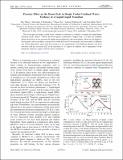Pressure Effect on the Boson Peak in Deeply Cooled Confined Water: Evidence of a Liquid-Liquid Transition
Author(s)
Wang, Zhe; Kolesnikov, Alexander I.; Ito, Kanae; Podlesnyak, Andrey; Chen, Sow-Hsin
DownloadPhysRevLett.115.235701.pdf (1.407Mb)
PUBLISHER_POLICY
Publisher Policy
Article is made available in accordance with the publisher's policy and may be subject to US copyright law. Please refer to the publisher's site for terms of use.
Terms of use
Metadata
Show full item recordAbstract
The boson peak in deeply cooled water confined in nanopores is studied to examine the liquid-liquid transition (LLT). Below ∼180 K, the boson peaks at pressures P higher than ∼3.5 kbar are evidently distinct from those at low pressures by higher mean frequencies and lower heights. Moreover, the higher-P boson peaks can be rescaled to a master curve while the lower-P boson peaks can be rescaled to a different one. These phenomena agree with the existence of two liquid phases with different densities and local structures and the associated LLT in the measured (P, T) region. In addition, the P dependence of the librational band also agrees with the above conclusion.
Date issued
2015-12Department
Massachusetts Institute of Technology. Department of Nuclear Science and EngineeringJournal
Physical Review Letters
Publisher
American Physical Society
Citation
Wang, Zhe, Alexander I. Kolesnikov, Kanae Ito, Andrey Podlesnyak, and Sow-Hsin Chen. "Pressure Effect on the Boson Peak in Deeply Cooled Confined Water: Evidence of a Liquid-Liquid Transition." Phys. Rev. Lett. 115, 235701 (December 2015). © 2015 American Physical Society
Version: Final published version
ISSN
0031-9007
1079-7114